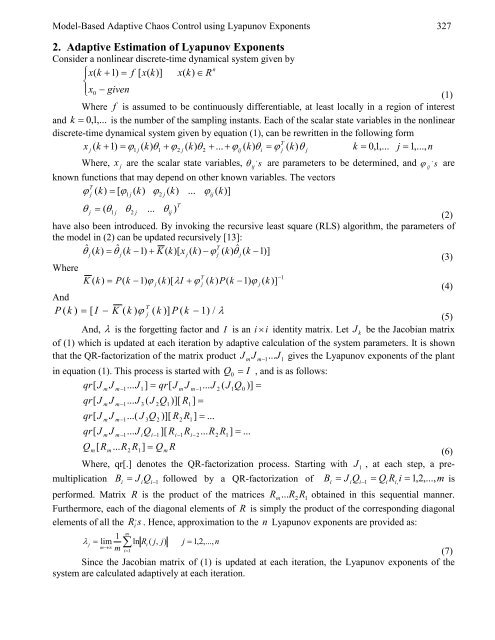European Journal of Scientific Research - EuroJournals
European Journal of Scientific Research - EuroJournals
European Journal of Scientific Research - EuroJournals
You also want an ePaper? Increase the reach of your titles
YUMPU automatically turns print PDFs into web optimized ePapers that Google loves.
Model-Based Adaptive Chaos Control using Lyapunov Exponents 327<br />
2. Adaptive Estimation <strong>of</strong> Lyapunov Exponents<br />
Consider a nonlinear discrete-time dynamical system given by<br />
n<br />
⎪⎧<br />
x(<br />
k + 1)<br />
= f [ x(<br />
k)]<br />
x(<br />
k)<br />
∈ R<br />
⎨<br />
⎪⎩ x0<br />
− given<br />
(1)<br />
Where f is assumed to be continuously differentiable, at least locally in a region <strong>of</strong> interest<br />
and k = 0,<br />
1,...<br />
is the number <strong>of</strong> the sampling instants. Each <strong>of</strong> the scalar state variables in the nonlinear<br />
discrete-time dynamical system given by equation (1), can be rewritten in the following form<br />
T<br />
x j ( k + 1)<br />
= ϕ 1 j ( k)<br />
θ1<br />
+ ϕ2<br />
j ( k)<br />
θ 2 + ... + ϕij<br />
( k)<br />
θi<br />
= ϕ j ( k)<br />
θ j k = 0,<br />
1,...<br />
j = 1,...,<br />
n<br />
,<br />
,<br />
Where, x j are the scalar state variables, θ ij s are parameters to be determined, and ϕ ij s are<br />
known functions that may depend on other known variables. The vectors<br />
T<br />
ϕ ( k)<br />
= [ ϕ ( k)<br />
ϕ ( k)<br />
... ϕ ( k)]<br />
j<br />
1 j<br />
2 j<br />
ij<br />
θ j = ( θ1<br />
j θ2<br />
j ...<br />
T<br />
θij<br />
)<br />
(2)<br />
have also been introduced. By invoking the recursive least square (RLS) algorithm, the parameters <strong>of</strong><br />
the model in (2) can be updated recursively [13]:<br />
ˆ ˆ<br />
T<br />
θ ( ) ( 1)<br />
( )[ ( ) ( ) ˆ<br />
j k = θ j k − + K k x j k −ϕ<br />
j k θ j ( k −1)]<br />
(3)<br />
Where<br />
T<br />
−1<br />
K ( k ) = P(<br />
k −1)<br />
ϕ j ( k )[ λI<br />
+ ϕ j ( k ) P(<br />
k −1)<br />
ϕ j ( k )]<br />
(4)<br />
And<br />
T<br />
P ( k ) = [ I − K ( k ) ϕ j ( k )] P ( k − 1)<br />
/ λ<br />
(5)<br />
And, λ is the forgetting factor and I is an i × i identity matrix. Let J k be the Jacobian matrix<br />
<strong>of</strong> (1) which is updated at each iteration by adaptive calculation <strong>of</strong> the system parameters. It is shown<br />
that the QR-factorization <strong>of</strong> the matrix product J m J m−<br />
1...J1<br />
gives the Lyapunov exponents <strong>of</strong> the plant<br />
in equation (1). This process is started with Q 0 = I , and is as follows:<br />
qr[<br />
J J ... J ] = qr[<br />
J J ... J ( J Q )] =<br />
qr[<br />
J<br />
qr[<br />
J<br />
qr[<br />
J<br />
m<br />
m<br />
m<br />
m<br />
J<br />
J<br />
J<br />
m−1<br />
m−1<br />
m−1<br />
m−1<br />
... J<br />
...( J Q )][ R R ] = ...<br />
... J<br />
1<br />
3<br />
i<br />
( J Q )][ R ] =<br />
3<br />
Q<br />
2<br />
2<br />
i−1<br />
1<br />
][ R<br />
m<br />
2<br />
i−1<br />
R<br />
m−1<br />
1<br />
1<br />
i−<br />
2<br />
... R<br />
2<br />
2<br />
R<br />
1<br />
1<br />
0<br />
] = ...<br />
Qm<br />
[ Rm<br />
... R2<br />
R1]<br />
= Qm<br />
R<br />
(6)<br />
Where, qr[.] denotes the QR-factorization process. Starting with J 1 , at each step, a pre-<br />
B J Q followed by a QR-factorization <strong>of</strong> = J Q − = Q R i = 1,<br />
2,...,<br />
m is<br />
multiplication i = i i−1<br />
performed. Matrix R is the product <strong>of</strong> the matrices ... R2R1<br />
Bi i i 1 i i,<br />
Rm obtained in this sequential manner.<br />
Furthermore, each <strong>of</strong> the diagonal elements <strong>of</strong> R is simply the product <strong>of</strong> the corresponding diagonal<br />
elements <strong>of</strong> all the<br />
,<br />
s . Hence, approximation to the n Lyapunov exponents are provided as:<br />
R i<br />
m 1<br />
λ j = lim ∑ ln Ri<br />
( j,<br />
j)<br />
j = 1,<br />
2,...,<br />
n<br />
m→∞<br />
m i=<br />
1<br />
(7)<br />
Since the Jacobian matrix <strong>of</strong> (1) is updated at each iteration, the Lyapunov exponents <strong>of</strong> the<br />
system are calculated adaptively at each iteration.

















